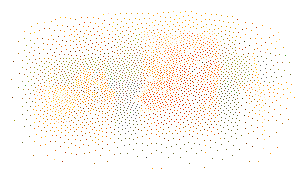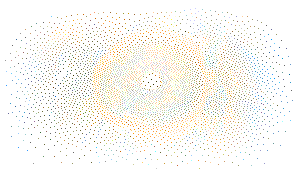Jussi Parikka

Multiscalar Media Matter

Carbon Topologies by Manifest Data Lab, installed at Weather Engines exhibition, Onassis Stegi, Athens 2022.

Mycelium Garden by Matthias Fritsch, installed at Weather Engines exhibition, Onassis Stegi, Athens 2022.

Proxy Climates, by Anca Benera & Arnold Estefan, installed at Weather Engines exhibition, Onassis Stegi, Athens 2022.
Transcript
I work with matter, but then again, who doesn’t?
Not that there haven’t been attempts to claim the opposite: that one works with only ethereal, immaterial thoughts, with concepts that have no weight, that operate according to a different register of reality. I never had much time for that myself. I was always interested in matter as it surrounds us, or us as matter, matter that is experienced, but also, not directly apparent to us. Not all matter is a thing, even if things are all around us. Let me try to explain what I mean.
I am often referred to as a media theorist, although what really interests me is the material world of relations. True, I deal with technologies, with digital culture, and even those anomalous sides that are not necessarily apparent as tangible entities. I write about software that cannot be seen or smelled but makes worlds appear, I research infrastructures that determine the here and the now even if they are somewhere else – such as cloud computing. I am interested in design but not necessarily of just a thing but a relation, an affect, a state of being and becoming, a milieu that is populated across different scales. I deal with the ecology – both in the sense of the environmental damage we are in but also how we come about knowing this damage.
So many others have already pointed to this topic. Feminist studies of technology and nature, new materialist philosophers, different strands of critical and creative engagement with materiality of labour, materiality of media, materiality of affective realities. Building on that, I have been fascinated with the question of how matter is about scale, how ecological matter is about scales of knowing, and how infrastructures of knowing are part of that matter too.
Take an obvious example, the climate. The climate itself is an abstraction but a totally necessary one: a statistical understanding of large scale patterns across decades. As they say, climate cannot be sensed, only weather can. But we can sense the sensing of climate. We can know about how we know climate as technological models, as ways of knowing, as statistical reasoning and understanding how we come to know things that are not yet here – such as future models, forecasting, possible pathways. The matter of climate change is both the historical trajectory and the many possible futures that might or might not happen. We deal with this planetary scale matter in this back and forth of concrete and abstract, both as real. This is also about media and mediation and at which scale we are able to sense.
I recently curated an exhibition called Weather Engines in Athens. Together with Daphne Dragona we curated a show about weather and technology. But at the same time, it became an exhibition about scales of sensing: at which point, in which matters, does slow change become visible or audible? If in the age of anthropogenic climate change all weather is artificial, which artefacts come to matter in ways that is both aesthetic and epistemic? Some of our artists and their works deal with bioindicators: living matter that has its own cycle of life and exchange with the world; but also, is an indicator of patterns beyond it.
Biodincators register the world. My friend and inspiring colleague Susan Schuppli speaks of material witnessing.
Pollen samples across decades, mushroom growth, insects such as dragonflies, and environmental surfaces such as soil. See what I mean by scale of matter? Scale of ecological matter? That one thing is one thing but also much more. Another thing but not just a thing but a bundle of relations, it relates to a variety of durations of other matters too. That sentence might sound a bit cumbersome, but it is actually quite straightforward: we read other worlds through matter that is expressive, full of potential, but also full of histories of how it has interacted with the world beyond itself. Matter as such can be an indicator of planetary scale too.
Now, this is also a concrete problem when trying to convey abstractions such as climate change or for that matter, capitalism. Earlier other theorists referred to cognitive mapping in this manner: what forms of images, maps, concepts make sense of that which is of a different scale, so vast that it cannot be pinpointed into one object. This problem of matter then returns in this guise, when artists and others are trying to make sense of abstractions such as climate: how to make concrete something that is not? What is the balancing act to hold together different temporal durations.
Let’s rewind a bit.
Earlier, I wrote a book called A Geology of Media that was somewhat a response, or at least a set of questions, in this manner: about matter, scale, media, technologies. It is a book about the incommensurability of different durations of matter that also affects how we see and view planetary scale dynamics: atmospheric gases or toxification and pollution of soil might be not really what media studies is about, but these are dynamics that are central to industrial culture. Such matters are not part of the vocabulary of media studies which does not lessen the important task of having to consider what our disciplines are at this very moment of time: at scales of global pandemic, at scales of violence against humans and non-humans in Ukraine and other sites of conflict, but also, this pattern of climate change and biodiversity crisis that will produce further violence. Such matters of complex entanglements of matter is the context in which media studies, design studies, architecture, data sciences and data studies, machine learning and AI, and much beyond has to operate.
So, when responding to the theme of matter, we are also responding, by necessity, to how we know matter. What disciplines, what images, what sensations are compiled in the bundle of methods that address this matter, this matter that is also some other matter.
All images courtesy of Stelios Tzetzias
Daphne Dragona and Jussi Parikka Weather Engines in Athens
Susan Schuppli, Material Witness: Media, Forensics, Evidence
Jussi Parikka, Geology of Media
Jussi Parikka is a writer and professor in digital aesthetics and culture at Aarhus University. He is also Visiting Professor at FAMU in Prague and Winchester School of Art. In 2021, he was elected as member of Academia Europeae. Parikka’s books have addressed a wide range of topics contributing to a critical understanding of network culture, aesthetics and media archaeology of contemporary society. The books include the media ecology-trilogy Digital Contagions (2007, 2nd. ed 2016), the award-winning Insect Media (2010) and A Geology of Media (2015), which addresses the environmental contexts of technical media culture. This topic was continued in the short booklet A Slow, Contemporary Violence: Damaged Environments of Technological Culture (2016) and in the short co-authored book Remain (2019)

